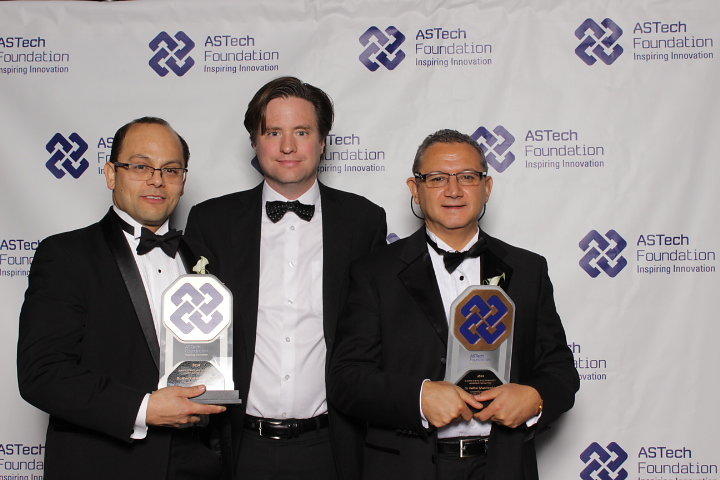
Bill Rosehart, dean of engineering, centre, with Alex Ramirez-Serrano, left, and Fadhel Ghannouchi.
Oct. 28, 2014

Bill Rosehart, dean of engineering, centre, with Alex Ramirez-Serrano, left, and Fadhel Ghannouchi.
Two University of Calgary faculty members received top honours at the annual Alberta Science and Technology (ASTech) Leadership Foundation awards held on Oct. 24. Fadhel Ghannouchi and Alex Ramirez-Serrano, from the Schulich School of Engineering, accepted the awards. The annual event recognizes outstanding individuals and organizations in Alberta’s science and technology community.
“Congratulations to Fadhel Ghannouchi and Alex Ramirez-Serrano for their remarkable achievements and the industry recognition they so clearly deserve,” says Bill Rosehart, dean of the Schulich School of Engineering.
Alex Ramirez-Serrano
Alex Ramirez-Serrano is the recipient of the 2014 Outstanding Achievement in Applied Technology and Innovation Award. His passion for mobile robotics began when he saw the first release of Star Wars. “As a kid I always wanted to work on something that you can see, feel and that would make the world a better place,” Ramirez-Serrano says.
Professor Ramirez-Serrano researches the development, commercialization and service of custom, highly-manoeuvrable unmanned and ground vehicles (UAVs and UGVs).
Since the earliest modern UAV work in the 1950s, researchers started to develop UAV technology but needed to overcome many challenges, including flying, communicating and controlling them. As the technology evolved, Ramirez-Serrano saw the potential for UAVs to be used in critical applications in confined spaces such as urban search, rescue missions, and below the tree canopy. “Many people started with aerial vehicles but for some reason everybody just focused on flying outside. Nobody really flies in caves and tunnels and that’s one thing we said, ‘there’s a need in these spaces,’” he explains.
“We started thinking of a way for a computer to take the exact shape of the aircraft, whatever that shape is, and wiggle it through the environment according to how it can fly,” he added.
These advancements in technology have allowed the development of a UAV capable of performing highly stable acrobatic manoeuvres that no other vehicle can execute. “Sometimes we need technology such as UAVs that can go there. There’s bad weather? There is no GPS? We don’t have a map of the environment? No problem; my UAV can actually go there because it can manoeuvre and navigate and I can provide the assistance right away.”
Ramirez-Serrano says the long-term goal of UAVs will be to adapt as the system, environment, or mission changes. “In engineering you hear a lot of people developing optimal solutions. I’m not against optimal solutions but I don’t really believe in them. An optimal solution for today may not be an optimal solution for tomorrow.”
Fadhel Ghannouchi
Fadhel Ghannouchi is the recipient of the 2014 Outstanding Leadership in Alberta Technology Award. His work is focused on understanding the urgent need for more sustainable technologies related to the explosive growth of communication networks.
“With the trend and evolution of technology, we cannot grow without watching how much energy we are consuming,” Ghannouchi says.
Currently information and communication technology (ICT) infrastructure consumes five per cent of global energy consumption. This figure is expected to rise by as much as 20 per cent in the next three to four years.
As a University of Calgary professor, Alberta Innovates Technology Futures (AITF) Strategic Chair and a Tier 1 Canada Research Chair in Green Radio Systems, Ghannouchi is at the forefront of improving the sustainability of radio and communications systems.
In 2005 Ghannochi founded the state-of-the-art Intelligent RF Radio Technology Laboratory (iRadio Lab). Since then, he has successfully demonstrated that energy consumption of typical fourth-generation wireless transmitters can be reduced by 50 per cent without compromising quality or speed. He has also developed new technology allowing three wireless operators to share and use the same base station.
He noted that traditionally people either work on the analogue electronics or in signal processing and these groups typically don’t communicate back and forth. “One of our strengths in the lab and at the University of Calgary is to try and bridge these two areas to try and see the problem from different perspectives.”
The success of this approach is seen in the world-class advances Ghannouchi and his team are making in the future of radio frequency and wireless technologies.